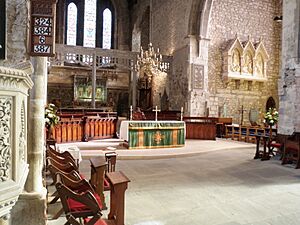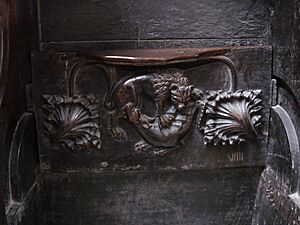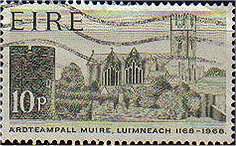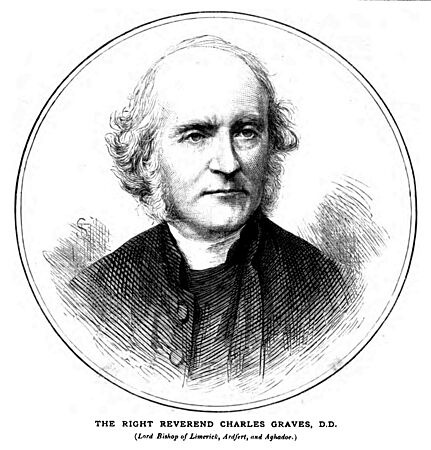St Mary's Cathedral, Limerick facts for kids
Quick facts for kids Saint Mary's Cathedral |
|
|---|---|
| The Cathedral Church of the Blessed Virgin Mary, Limerick |
|
|
Ardeaglais Mhuire, Luimneach
|
|
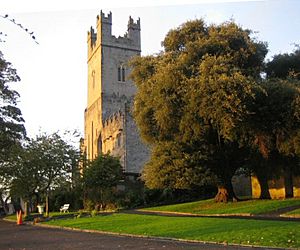 |
|
| 52°40′06″N 8°37′24″W / 52.66833°N 8.62333°W | |
| Location | Bridge Street, Limerick |
| Country | Ireland |
| Denomination | Church of Ireland |
| Churchmanship | High Church |
| Website | https://www.saintmaryscathedral.ie/ |
| History | |
| Founded | 1168 |
| Founder(s) | King Domhnall Mhor O'Brien |
| Dedication | Mary (mother of Jesus) |
| Architecture | |
| Functional status | In use |
| Heritage designation | Grade 1 |
| Architectural type | Church |
| Style | Gothic |
| Groundbreaking | c.1168 |
| Specifications | |
| Capacity | 300 |
| Bells | 9 |
| Administration | |
| Diocese | Tuam, Limerick and Killaloe |
| Province | Province of Dublin |
Saint Mary's Cathedral in Limerick, Ireland, is a special church dedicated to the Blessed Virgin Mary. It belongs to the Church of Ireland. This beautiful cathedral is one of the oldest buildings in Limerick that is still used today. It became a Church of Ireland cathedral after a big change in religion called the Reformation and is now one of six cathedrals in the Diocese of Tuam, Limerick and Killaloe.
Contents
History of Saint Mary's Cathedral
Saint Mary's Cathedral was founded in 1168. It stands on King's Island, where the last King of Munster, Domnall Mór Ua Briain, had his palace. People believe parts of his old palace might still be inside the cathedral. For example, the large west door is thought to be the original entrance to the royal palace. Bishops of Limerick still use this door for their special installation ceremonies.
During old battles and sieges of Limerick, people used the stones around the west door to sharpen their swords and arrows. You can still see the marks they made on the stone today!
The Cathedral Tower and Bells
The tall tower of Saint Mary's Cathedral was added in the 14th century. It reaches 36.58 metres (120 feet) high. Inside the tower, there are 8 bells that can be rung. Six of these bells were made by John Taylor & Co, and two were made in London. There is also a special service bell that can be rung from the ground floor.
Special Features Inside the Cathedral
The cathedral has five beautiful chandeliers hanging from the ceiling. They are only lit for very special events. The three largest ones were made in Dublin and given to the cathedral in 1759.
Saint Mary's got its first organ in 1624. It has been updated many times over the years, most recently in 1968 and 2005.
In 1620, a judge named Luke Gernon described the cathedral as "not large, but lightsome, and by the providence of the Bishop fairly beautified within, and as gloriously served with singing and organs." This means he thought it was bright, beautiful, and had wonderful music.
The cathedral also has the only complete set of misericords left in Ireland. These are small wooden seats in the choir stalls that allowed monks to lean during long services.
The Great Altar
During the wars in the 1600s, the cathedral was used as a stable by soldiers for a short time. They also took away the cathedral's original 4-meter (13-foot) high altar. This altar was carved from a single piece of limestone. It was returned to the cathedral in the 1960s. It is the largest altar of its kind in Ireland and the UK. Today, it is used for communion services during important festivals.
Damage and Repairs
In 1691, during the Williamite Siege of Limerick, the cathedral was badly damaged. After the war ended, King William III gave £1,000 to help repair it. You can still see cannonballs from the 1691 siege inside the Glentworth Chapel (also known as Saint George's Chapel).
Modern Times at Saint Mary's
In 1968, the Irish Government made two special postage stamps to celebrate the cathedral's 800th birthday. One of these stamps is shown on this page.
From 1991 to 1996, a big restoration project took place. This included digging up and re-laying the floors and installing underfloor heating. Smaller restoration work continues even today to keep the building in good condition.
Saint Mary's Today
Today, Saint Mary's Cathedral is still an active place of worship and prayer for everyone. It is also a very popular place for tourists to visit in Limerick, being the third most visited attraction. It is open to the public every day. There is a small admission fee for tourists, which helps pay for the cathedral's upkeep. This money is very important for keeping this historic building running.
In recent years, the cathedral has seen some important changes in its leadership. In 2012, Reverend Sandra Ann Pragnell became the first female Dean of the cathedral. She retired in 2017. Later that year, Reverend Canon Niall James Sloane became the 63rd Dean of Limerick.
The cathedral grounds also have a special United Nations Memorial Plaque. It lists the names of all the Irish men who died while serving as United Nations Peacekeepers.
Notable Burials
The graveyard around the cathedral is the final resting place for many important people. These include the doctor Samuel Crumpe, Prince Milo of Montenegro, and Frances Condell, who was the first woman Mayor of Limerick. Bishop Charles Graves is also buried here.
It is believed that Domnall Mór Ua Briain, the last High King of Munster, was buried in the cathedral. Parts of his stone coffin can still be seen inside. Bishop Cornelius O'Dea and several other Bishops of Limerick are buried in a special vault under the chancel. You can also find the tombs of the Sexton, Barrington, Boyd, and Vanderkiste families near the south entrance.




